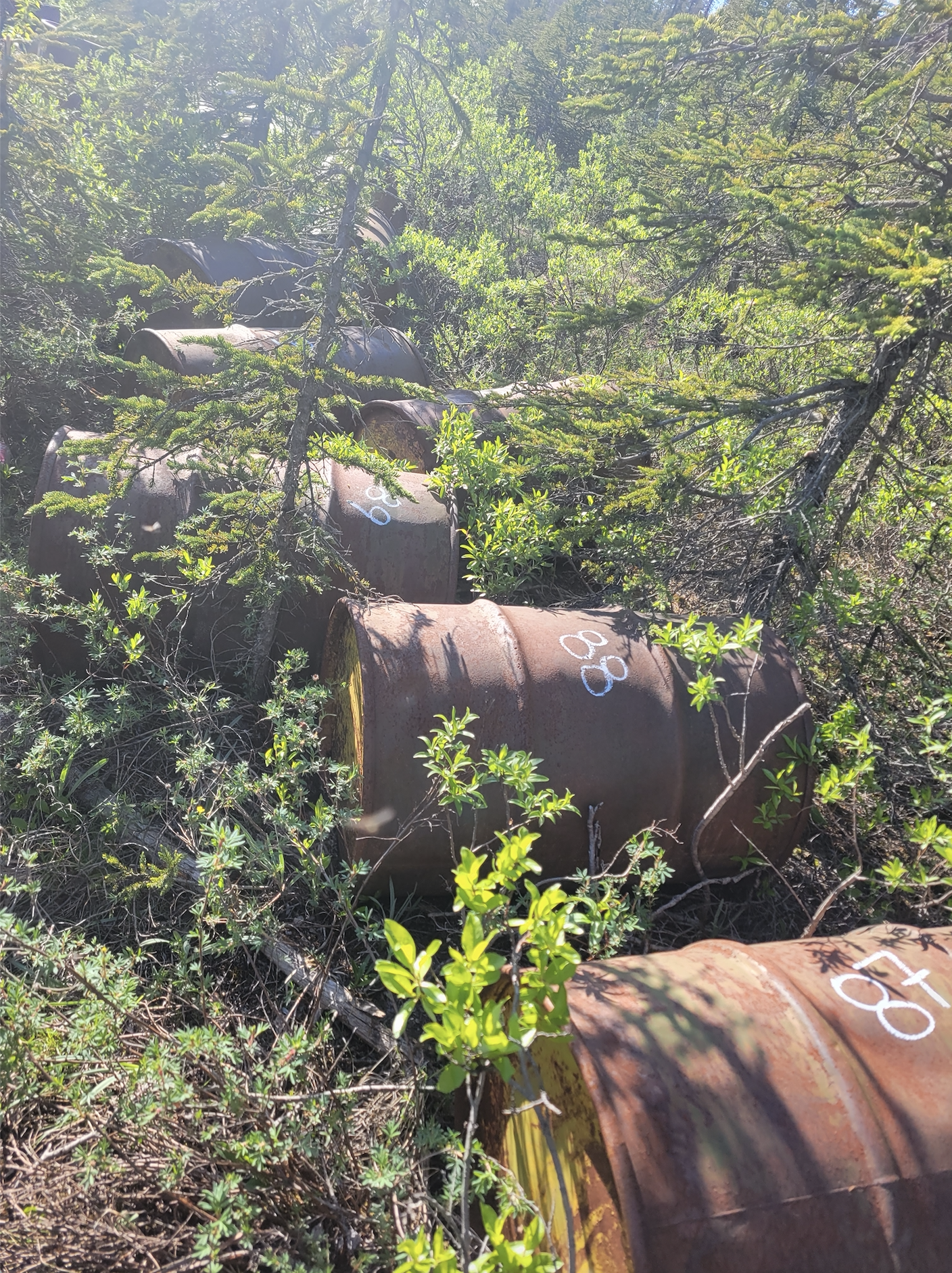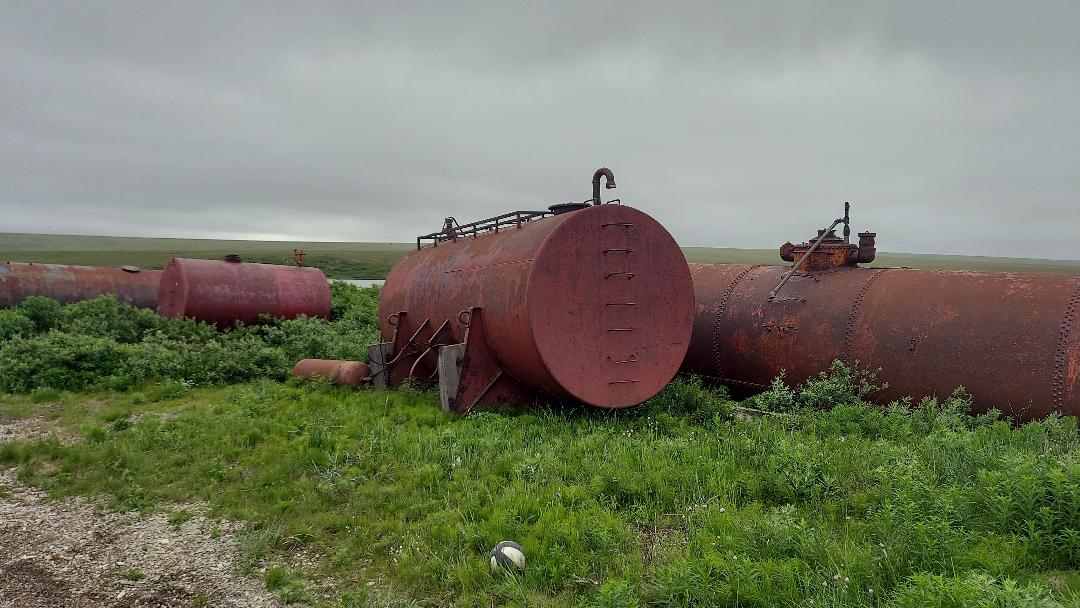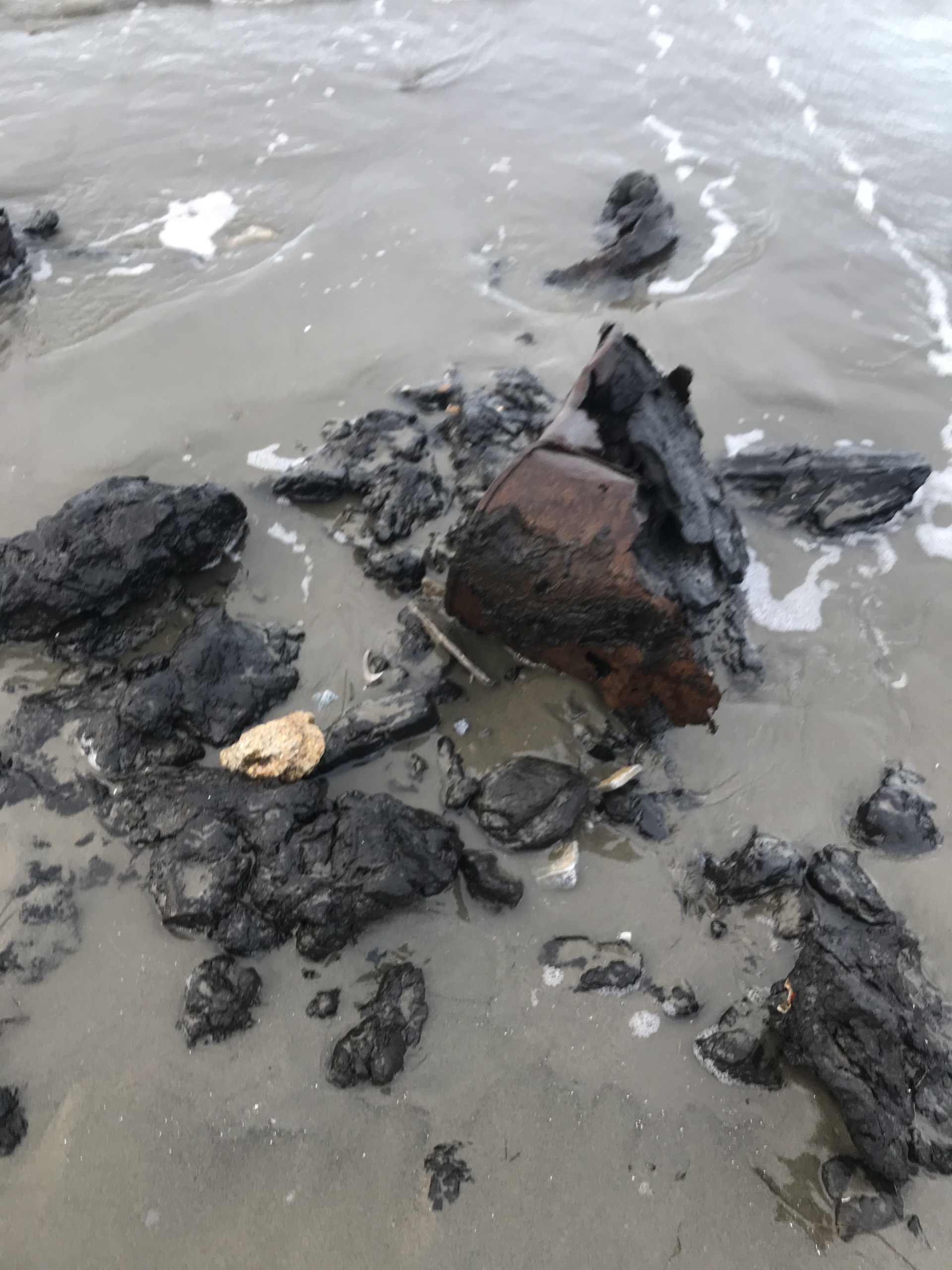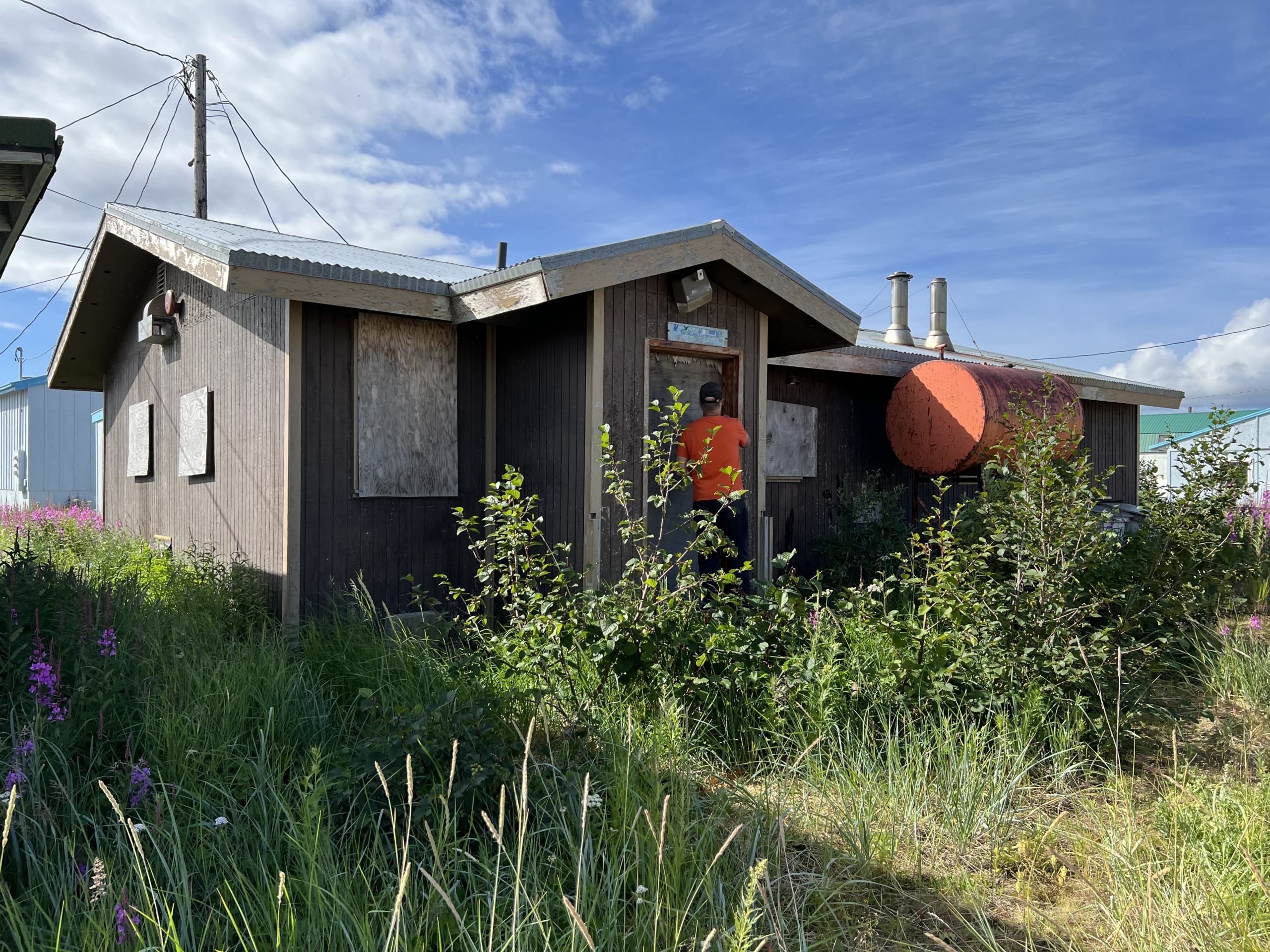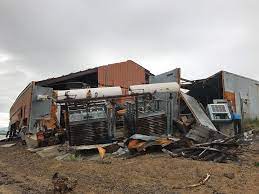WHITE MOUNTAIN BIA SCHOOL – DRUM STORAGE AREA
History:
The site is a four-acre drum dump site with diesel contamination that is approximately 1000, 55-gallon drums. According to 2001 evaluation conducted by the US Army Corps of Engineers, the White Mountain National Guard or Federal Scout Armory Site did not contain hazardous substances, pollutants, or contaminants eligible for cleanup under the Formerly Used Defense Site (FUDS) program. The Corps provided documentation indicating residents of White Mountain reported the drums contained fuel used at the BIA boarding school between 1948 and 1955. 2023 Update: After reviewing site history, DEC required more site characterization to confirm the number of drums present and delineate a total petroleum hydrocarbon (TPH) hit. Further site investigation in 2021 did not find any contaminants of concern above applicable state promulgated cleanup levels, but drums remain on site. BIA plans on removing the drums and fully characterizing the site.
Concerns:
Community’s concerned that drums have leaked petroleum products onto ground and are worried about the possible contamination of surrounding areas.
Actions:
9/7/2000: Update or Other Action: Letter sent to Alaska Army National Guard indicating that the database was updated to remove the Alaska Army National Guard as a responsible party and the site name was changed.
12/7/2001: Update or Other Action: Staff sent a message to the AK District Corps of Engineers requesting it re-evaluate the site for cleanup eligibility under the Formerly Used Defense Site (FUDS) Program. The Corps replied that it has a copy of the EPA preliminary assessment and will review the site in federal FY 03.
4/21/2003: Update or Other Action: Staff reviewed the Corps of Engineers FUDS program annual workplan. It does include funding to review this site for cleanup eligibility under the FUDS program. We should have a determination before the end of Sept. 2003.
3/15/2004: Update or Other Action: File number assigned: 580.38.002.
3/25/2004 : Update or Other Action: DEC received a letter and memo from the Corps of Engineers stating it has reviewed the available information and determined the site is not eligible for cleanup under the FUDS program. Their decision is based on a lack of documentation that the drums are from military operations, area residents’ recollection that the drums are from past operation of the BIA school between 1948 and 1955. During this era the military may have supplied fuel to BIA school under the Military Sea Transport Service (MSTS) Mona Lisa operation.
6/18/2004: Update or Other Action: DEC concurred with the Corps determination that the drum site is not eligible for cleanup under the FUDS program.
9/14/2004: Potentially Responsible Party/State Interest Letter: DEC sent a letter to BIA informing it on the drum disposal site, prior site characterization work, and efforts to identify a responsible party. BIA was advised that it appears to be responsible for the improperly disposed of drums, the potential for additional residue to leak, and the potential physical hazards posed by the solid waste. DEC requested BIA properly cleanup and dispose of the drums.
11/12/2004: Update or Other Action: BIA responded to the 9/14/2004 letter stating that it did not receive the attachments and requesting further information.
5/6/2008: Exposure Tracking Model Ranking: Site transferred to State/Private sites. Initial ranking with ETM completed.
3/29/2011: Update or Other Action: On this date, ADEC received a response from the White Mountain IGAP Tribal Coordinator. The Tribal Coordinator indicates that approximately 275 drums remain at site. Over time the villagers have used the drums for burn barrels or fuel storage. In 2008, the IGAP Program transported 120 drums to the landfill. The IGAP coordinator indicates that all the remaining drums are either empty and/or rusted through. The potential fate of the drums, at both the site and the land fill, are to either be transported to Nome’s drum crusher or for reuse by the village.
3/14/2012: Exposure Tracking Model Ranking: a new updated ranking with ETM has been completed for source area 74077 drum dump area.
12/2/2013: Update or Other Action: received email correspondence from IGAP Coordinator indicating that no drums remain on the site. All of the drums were transported to the landfill or were reused by the residents in White Mountain.
12/13/2013: Exposure Tracking Model Ranking: A new updated ranking with ETM has been completed for source area 74077 drum dump area.
8/7/2015: Update or Other Action: Reviewed file and transferred to PM Whitsel for further action and evaluation of BIA period of operation. PRP letter to BIA is in file but no further correspondence has been received from BIA. Further characterization is required at the site to delineate contaminated soil at former drum dump.
12/16/2015: Potentially Responsible Party/State Interest Letter: Sent PRP letter to BIA requiring them to complete the following two actions: 1.) Take confirmatory soil samples from the area with the greatest petroleum contamination, based on 1998 sampling; 2.) Evaluate soil samples for remaining contaminants; a.) If no contaminants are detected above applicable cleanup levels, DEC will issue a designation of “cleanup complete”. b.) If remaining contaminants are detected, remedial activity will be required.
6/8/2016: Update or Other Action: Received email correspondence from IGAP Coordinator that at least 50-100 drums remain on-site, many of which are obscured from view by brush. Most drums are open, but it is unknown whether anything remains in the drums.
9/16/2016: Update or Other Action: DEC responded to KNOM Radio questions regarding this site. The interviewer requested information on what was known about the drums, who was responsible for cleaning up the site, and additional details regarding site investigation and survey of the drums.
6/17/2019: Update or Other Action: Site location was updated on this date. Coordinates for this site are used to determine the presence and position of the site on BLM’s ANCSA Conveyed Land web map.
6/28/2019: Update or Other Action: Letter provided to BIA providing a list of 31 sites where BIA is a PRP and requesting a meeting to discuss long-term planning for cleanup at these sites.
7/19/2021: Update or Other Action: July 9th, a site visit (DEC not present) discovered 250 55-gallon drums at the site, the majority of which were intact. Most appeared to be empty. No odor and no visible signs of contamination were observed.
7/19/2021: Exposure Tracking Model Ranking: A new updated ranking with ETM has been completed for source area 74077 drum dump area.
7/29/2021: Document, Report, or Work plan Review – other: DEC sent comments on the draft 2021 Work Plan, which entails sampling surface soils around the remaining drums in the area. DEC had questions concerning screening methods for heavily weathered fuels, as well as drum disposal concerns and what COCs will be tested for.
9/21/2021: Document, Report, or Work plan Review – other: DEC Approved the Final Work Plan. Unfortunately, the contract and scope of work could not be adjusted to facilitate all of DEC’s recommended actions. All requested sampling and characterization activities that were not already scoped will be considered under the next contract and will be driven by what is found during this field season.
12/22/2021: Document, Report, or Work plan Review – other: DEC sent comments on the Draft Site Investigation Report. Discrete samples were taken from underneath several drums, and contents were also analyzed from two drums. Samples were analyzed for GRO, DRO, VOCs, PAHs, and drum contents were analyzed for TCLP VOCs/SVOCs and TCLP metals. No exceedances of any cleanup levels were detected. BIA recommends emptying and disposing of all drums, and ISM conducted in the main drum storage area, supplemented by discrete soil sampling.
3/14/2022: Site Characterization Report Approved: DEC approved the Final Site Investigation Report, which discusses soil sampling underneath discarded drums. Soil samples were analyzed for gasoline and diesel range organics (GRO and DRO), volatile organic compounds (VOCs), and polycyclic aromatic hydrocarbons (PAHs). Drum contents were sampled as well and analyzed for toxicity characteristic leaching procedure (TCLP) VOCs/semi-volatile organic compounds (SVOCs), and TCLP metals. No exceedances of any regulatory cleanup levels were detected. The report recommends all drums be emptied of contents and disposed of, and the footprint of the drum area be sampled with discrete sampling methodology.
6/2023: Contractor and Kawerak staff conducted a site visit.
Upcoming:
9/2023: Contractor and Kawerak staff will conduct testing on liquid waste to determine if they can be combined; containerize and sample wastes; submit samples to a lab for results.

